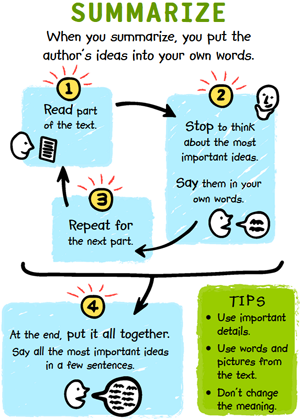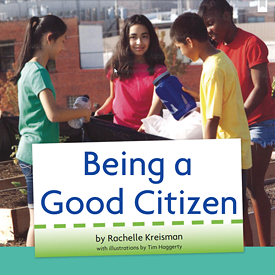Reading: Summarize
Reading: Summarize

There are many important ideas in informational texts. To make certain that you understand the important ideas, you should summarize. To do that, you will put the author’s ideas in your own words, or paraphrase.
Read the anchor chart and follow the numbers and arrows to know step-by-step how to summarize.
- Read part of the text.
- Stop to think about the most important ideas. Say them in your own words.
- Repeat for the next part.
- At the end, put it all together. Say all the important ideas in a few sentences.
Good readers don’t wait until they finish an informational text to identify important ideas. Instead, they identify important ideas as they read.
You should repeat steps 1, 2, and 3 on the chart several times. You might even record the important ideas while paraphrasing them. You will use what you do in steps 1, 2, and 3 to be able to complete step 4. Only the most important details will be included in step 4. It is important to not change the meaning of the text when using your own words. Remember to use words and pictures from the text to help you understand and summarize it.

Read Aloud: Student Instructions
To practice summarizing, read Being a Good Citizen (in your online textbook, click Module 1, then click the Contents menu at the top left of your browser, and click the book title).
Before you begin, PREVIEW the text and PREDICT what the text will be about. You may write your prediction down (optional). As you read the story, you can then confirm or reject your prediction.
Read Aloud Steps
- Step 1: Read each question aloud. Pause after each of the page numbers to think about your answer.
- Step 2: Answer the questions aloud with someone. You do not need to write or turn in the answers for this section.
Parent/Guardian: Check the student's responses with the answer key
, Reading: Summarize (1.2.4).
- p. 68: Why do you think the author began this section with a heading?
- p. 70:
- Why do you think the author uses the heading “Get Involved”? What do you think you will read about in this section?
- What is the purpose of “Just Joking!”
- Why do you think the author tells a joke?
Think Aloud (p. 71): This is a good place for me to stop and use my own words to tell how good citizens get involved. I know I should only use the important ideas in my summary. Good citizens can get involved by taking part in after-school activities. They can listen to local news to know what is going on in their community and then talk about it with a parent to share opinions.
- p. 74:
- What is the purpose of the Fun Fact?
- Why do you think the author included information in a special way?
- What is the heading on p. 74?
- What is this section mostly about?
- How can good citizens help others?
Think Aloud (p. 76): Now it is time for me to “put it all together” (STEP 4) and explain what the text is mostly about. I will use the headings in the text to help me. This text is mostly about how to be a good citizen in your community. One way to be a good citizen is to get involved by taking part in after-school activities. You can also follow and discuss local news and vote. Another way to be a good citizen is to help others by volunteering, donating, and doing small acts of kindness for others.
Texas Tech K-12
-
Address
Texas Tech Plaza | 1901 University Ave, Lubbock, TX 79401 -
Phone
(800) 692-6877 -
Email
ttuk12@ttu.edu

